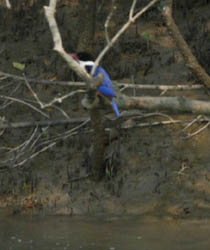


|
 |
||||||||||
| Contact Us | |||||||||||
|
North East India (
Calcutta
,
Orissa
, Bandhavgarh,
Kanha
, Khajuraho, Varanasi) |
|||||||||||
|
Maps |
India | N E India | N W India | Bombay (Mumbai) | Calcutta (Kolkata) | Delhi |
South India |
Anywhere |
|||
|
Sunderbans Tiger Reserve West Bengal The Sunderbans covers a land area of some 10,000 sq km, of which about 60% is in Bangladesh. This is part of the largest river deltas in the world formed by the rivers Ganges, Brahmaputra and Meghna, and is one of the worlds largest mangrove forests. The rivers and channels of the Sunderbans are a mixture of fresh and saline water and is extremely tidal. Many of the islands are in danger of disppearing due to rising sea levels and "climate change". All of the islands are strictly off limit for tourists and a special pass is required to even visit the area. With a tiger population (in 2001) of 245 this park has the largest tiger populations in India, although over such a vast and inaccessible area, the chances of actually seeing one are remote. The tigers are known to swim between the numerous islands and are known to be man-eaters The trip from Calcutta is just over 100km (about 2hours) with a further 3 hour boat trip to thr camp. We stayed at the Sunderbans Tiger Camp |
 |
 Sunderbans Tiger Reserve
We
visited the Sunderbans in December and the weather was good - chilly in
the morning then searing heat during the day. The Sunderbans Tiger Camp
is one of the few places which are permitted on the outskirts of the
Reserve. There are one or two government tourist lodges within the
reserve but these offer sparse and basic accomodation (and transport
links). The whole area is mainly water and mudbanks and we certainly
did not see even a glimpse of a tiger or any evidence of their
existence.
Sunderbans Tiger Reserve
We
visited the Sunderbans in December and the weather was good - chilly in
the morning then searing heat during the day. The Sunderbans Tiger Camp
is one of the few places which are permitted on the outskirts of the
Reserve. There are one or two government tourist lodges within the
reserve but these offer sparse and basic accomodation (and transport
links). The whole area is mainly water and mudbanks and we certainly
did not see even a glimpse of a tiger or any evidence of their
existence. The camp is close to a local village (dont aske me to name it) and we did take time to visit the local market. For those of you hoping to see a picture of a tiger then follow the link to Bandhavgarh and Kanha because you wont see any here. We took a total of 4 river cruises over the course of two days and although there were plentiful birdlife, monkeys and crocodiles to see, the Ganges Dolphins and man eating Bengal tigers were elusive.  Local industry is mainly agriculture, fishing and
tiger prawn seed collection. There is also honey collecting. For this
the honey collectors venture deep into the jungle. Sunderbans honey is
supposed to be one of the best in the world. The honey collectors
apparently wear masks on the back of their heads to try to disorientate
any tigers (who like to attack from the rear) nearby.
Local industry is mainly agriculture, fishing and
tiger prawn seed collection. There is also honey collecting. For this
the honey collectors venture deep into the jungle. Sunderbans honey is
supposed to be one of the best in the world. The honey collectors
apparently wear masks on the back of their heads to try to disorientate
any tigers (who like to attack from the rear) nearby.The boat safaris take you on a sedate cruise down the waterways of the forest |
|

|
||
 |
||
 |
 |
 |
 |

|
 |

|
 |
 |
India is one of last places in the world that you can see Tigers in the wild. This is mainly thanks to Project Tiger, which was launched in 1973. This was after the numbers of tigers was seen to have reduced from 40,000 at the beginning of the century to a survey in 1972 which could only find evidence of 1827. In 1970 a national ban on Tiger hunting was introduced. On the launch of Project Tiger various tiger reserves were set up in India based on a 'core buffer' strategy. Within the core areas no human activity was to take place and within the buffer zones, only a limited amount of 'conservation oriented land use' activities were allowed. To start with 9 reserves were created and there are now 27. The most important of which are probably Corbett in Uttaranchal, Kanha in Madhya Pradesh and Sunderbans in West Bengal. According to the Project Tiger official web sitesince the start of the Project (in 1972) the numbers of Tigers has increased from 1,827 up to 3,773 in 2001-2002. However, as these figures have not been updated for 6 years and we have read various newspaper stories claiming that two of the tiger reserves in Rajastan no longer have a tiger population, there is still great cause for concern. In fact there is an article in the press recently claiming that the reason no figures have been officially published for 6 years is that numbers have diminished dramatically from the 3,773 claimed in 2002 to just 1,411 this year. |
| Links Bandhavgarh Tiger Reserve Kanha Tiger Reserve Sunderbans Tiger Reserve Our trip to the Sunderbans was a complete disappointment and we certainly wouldn't go there again, but you might be lucky! |